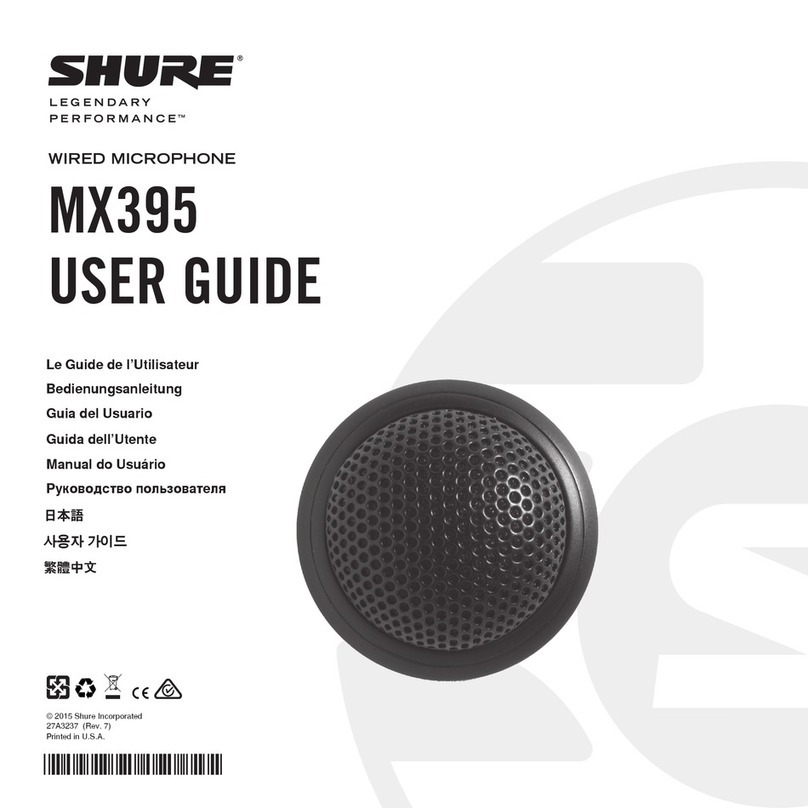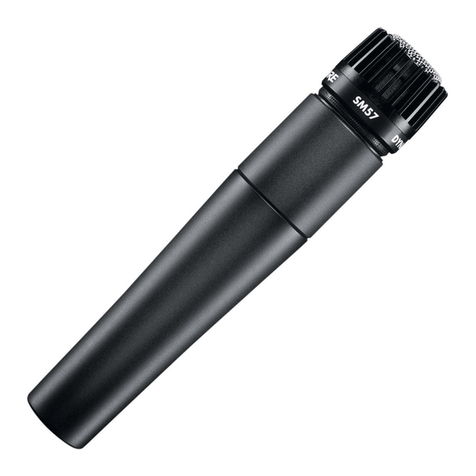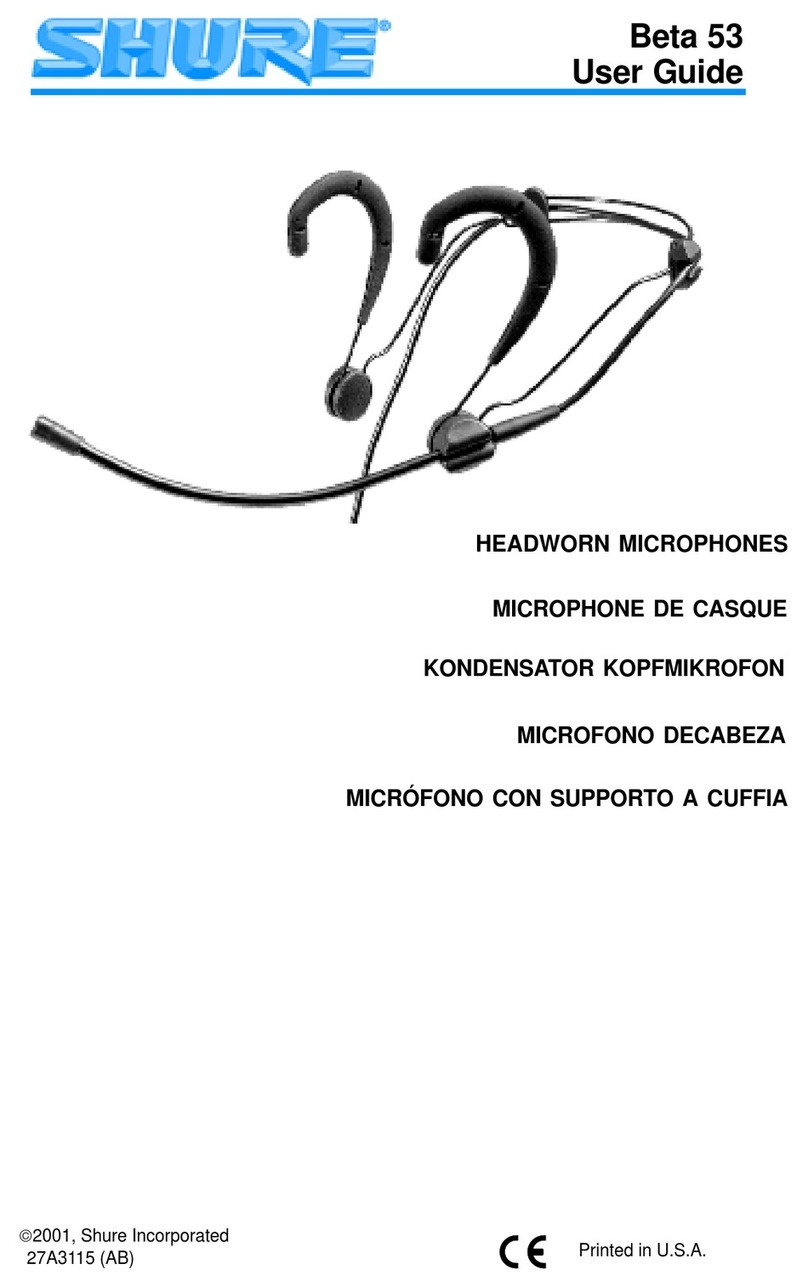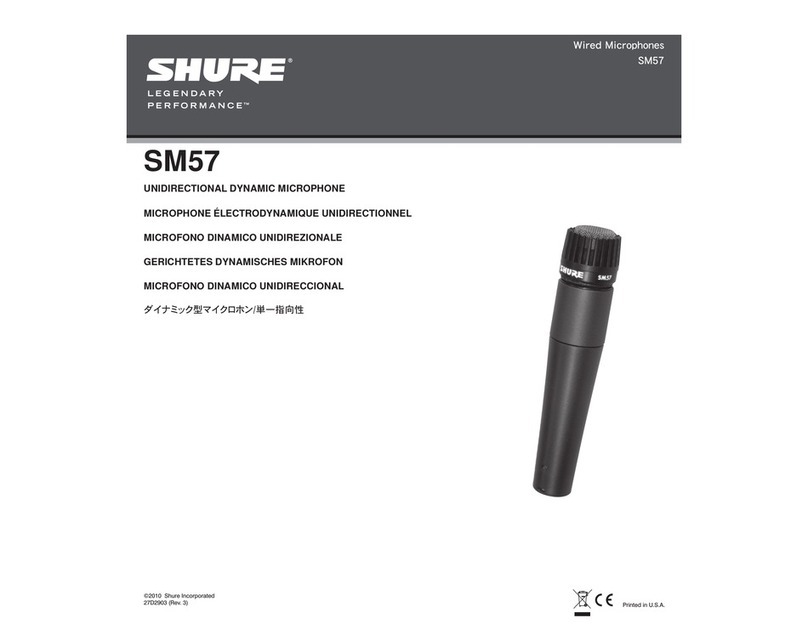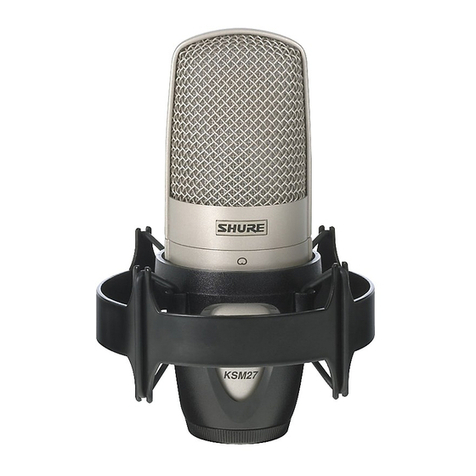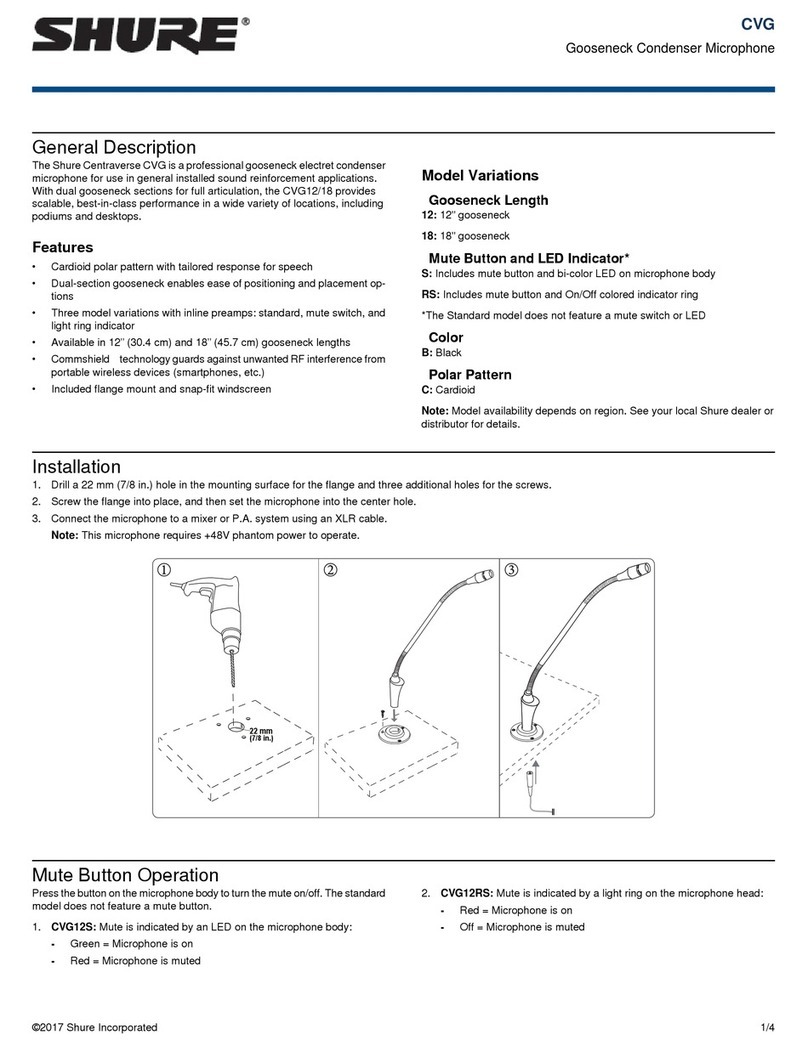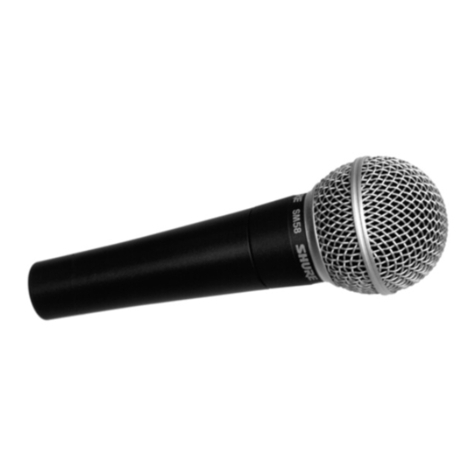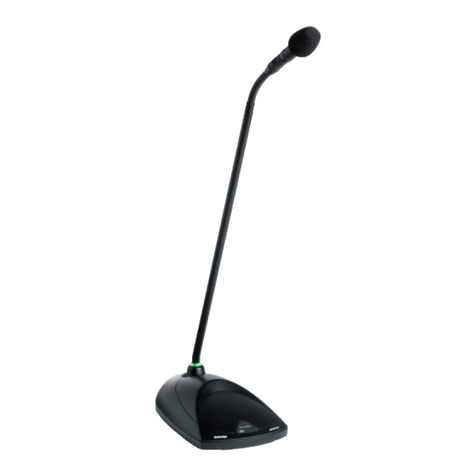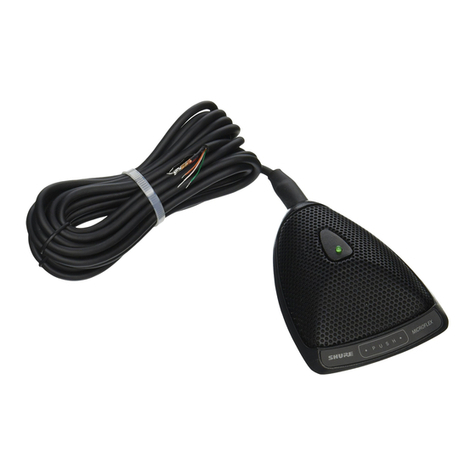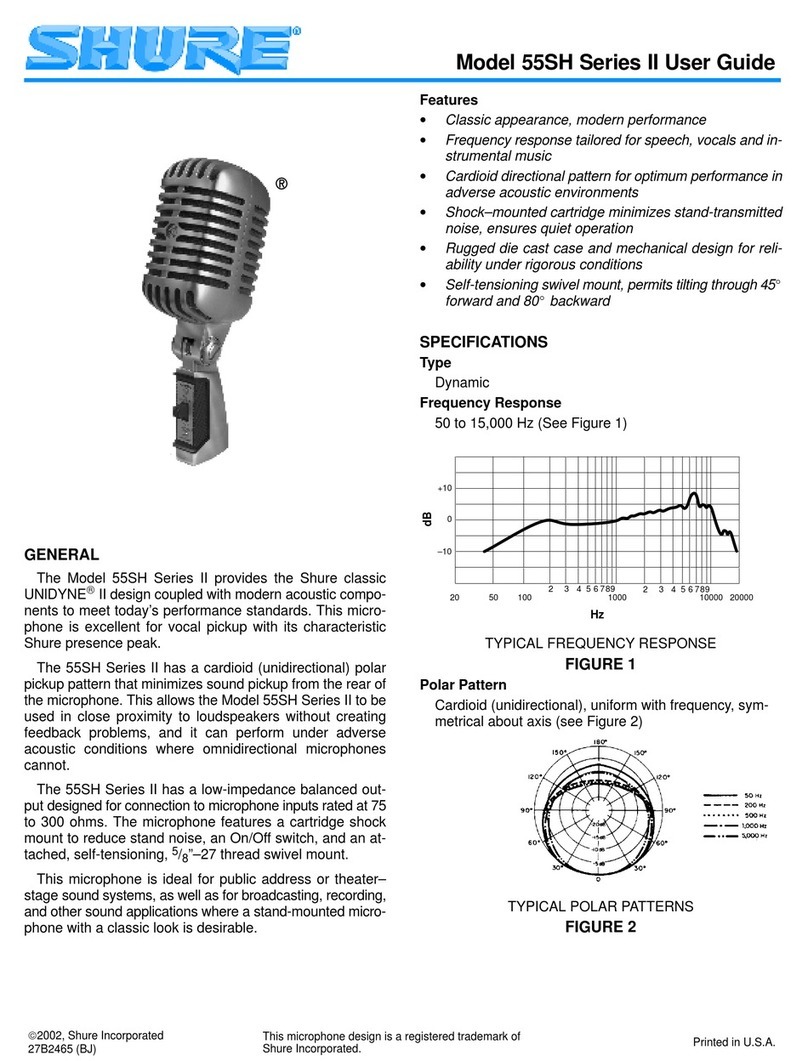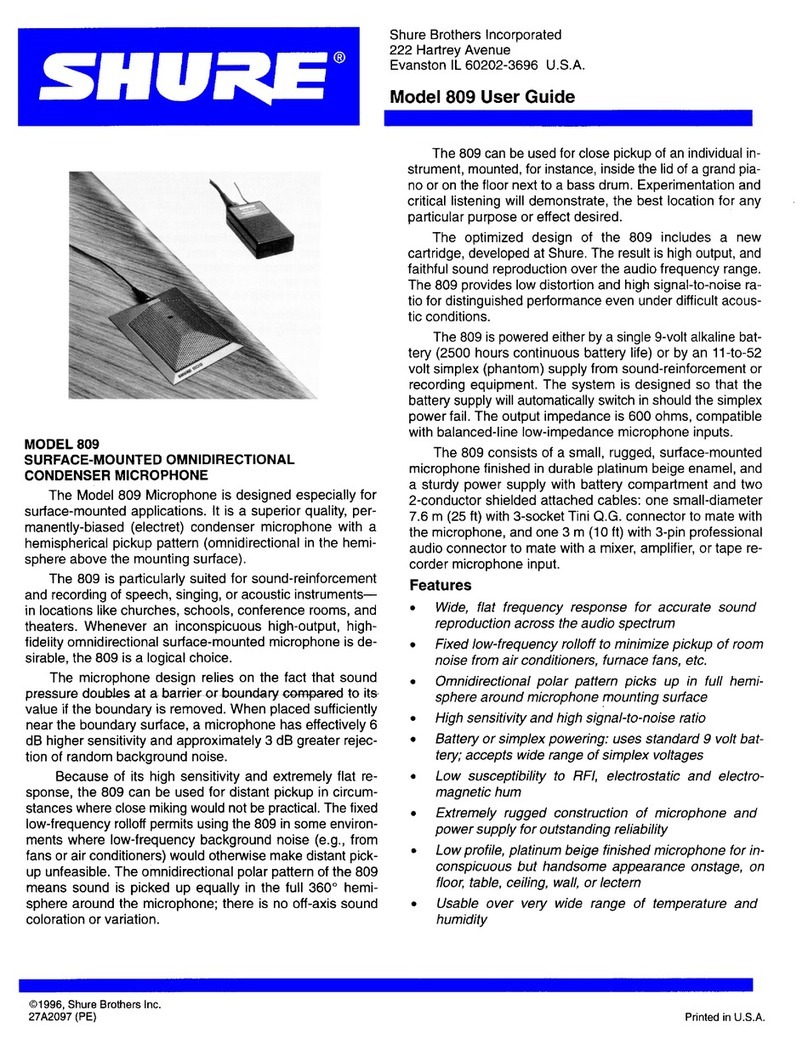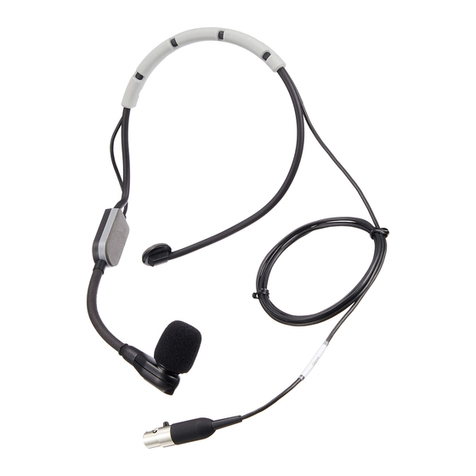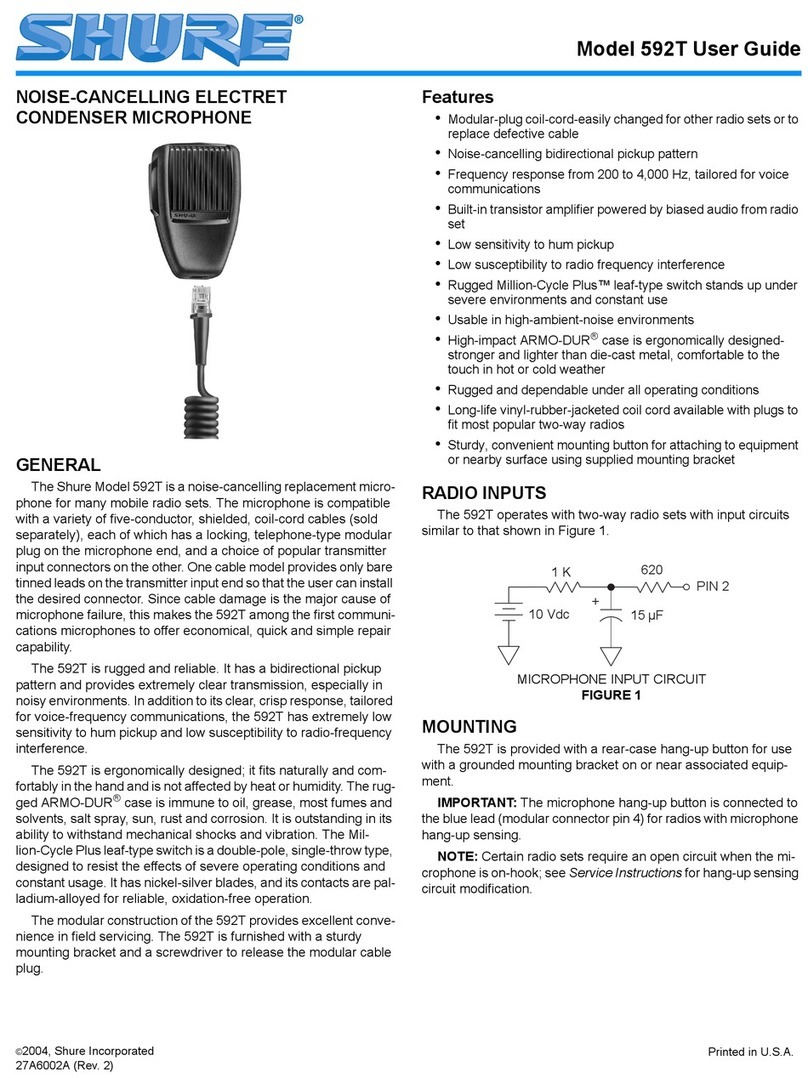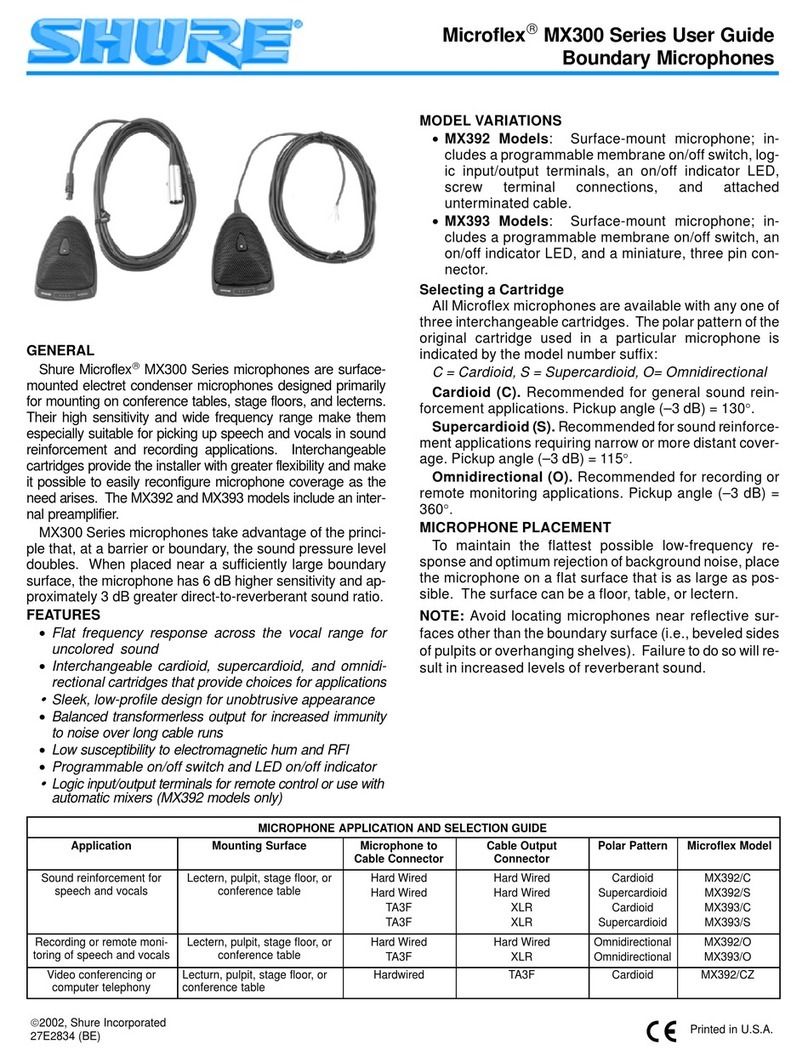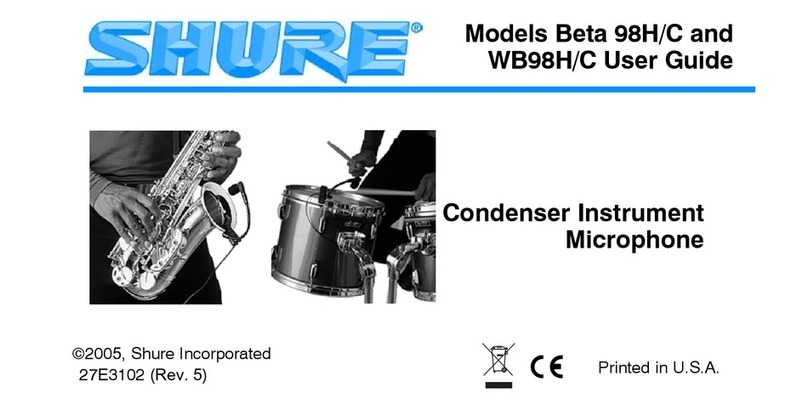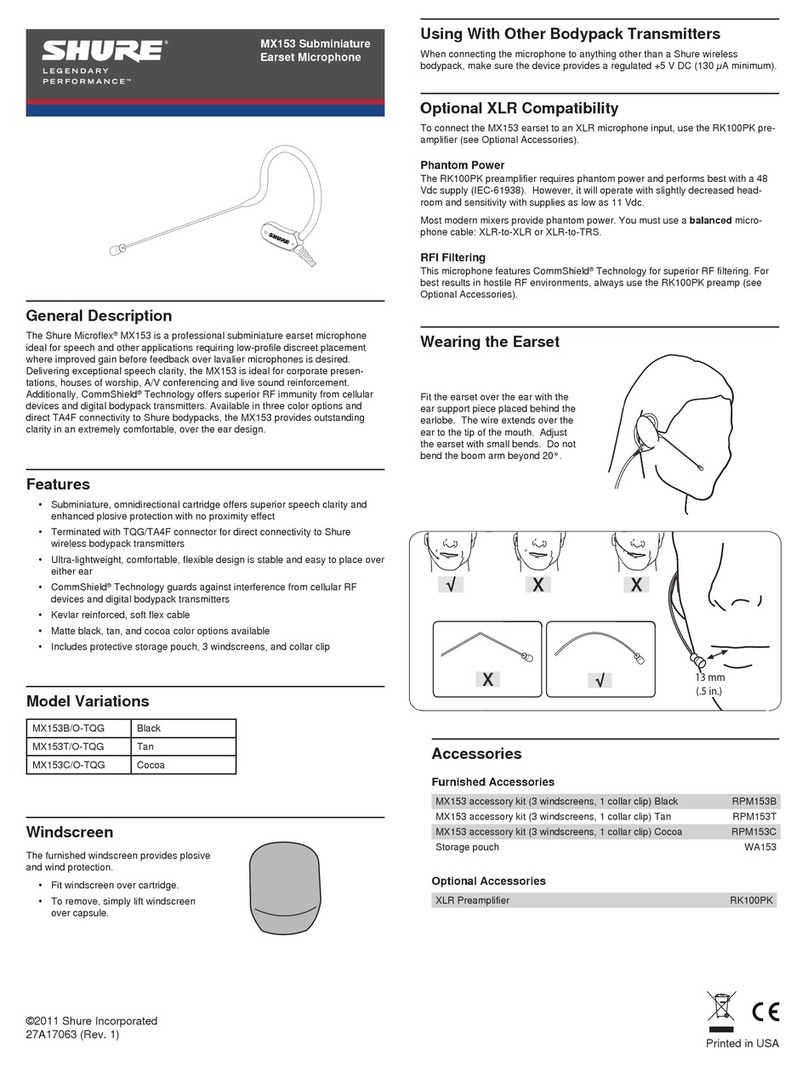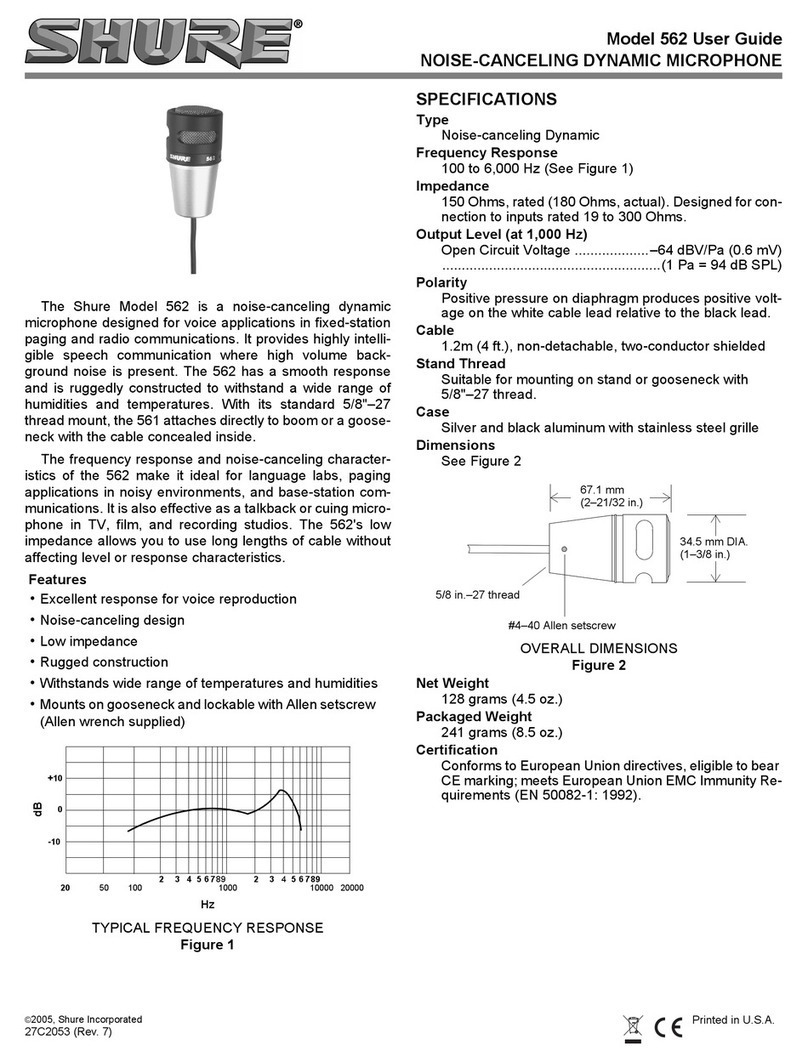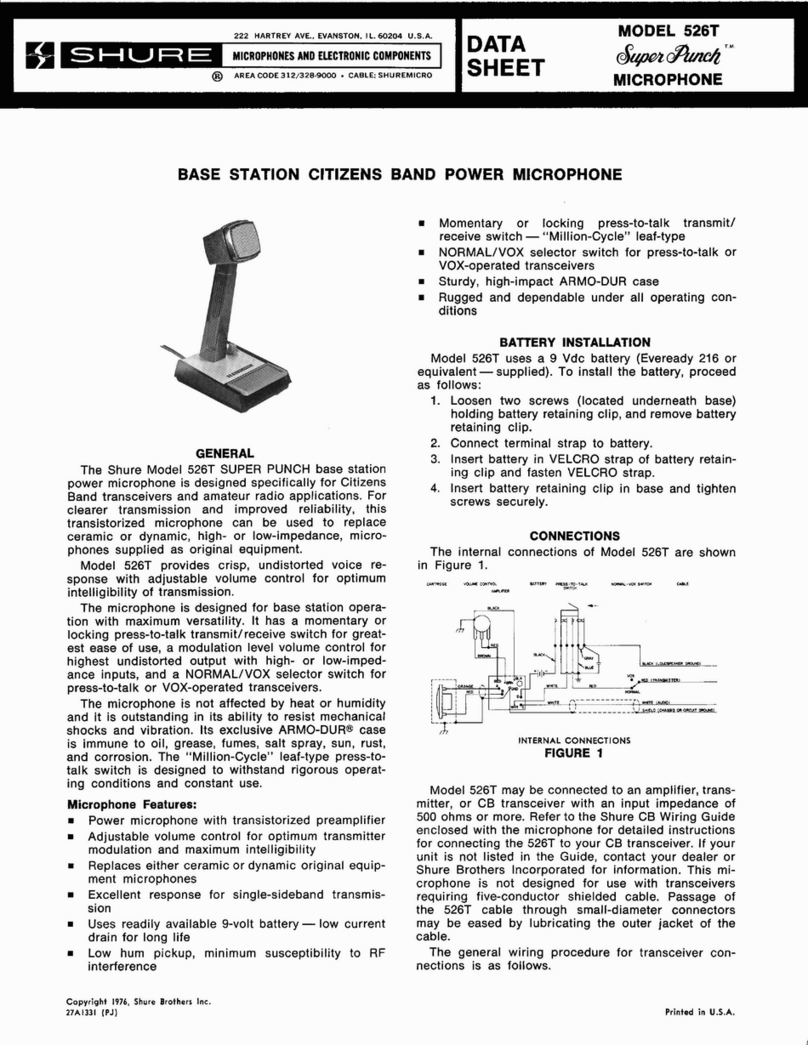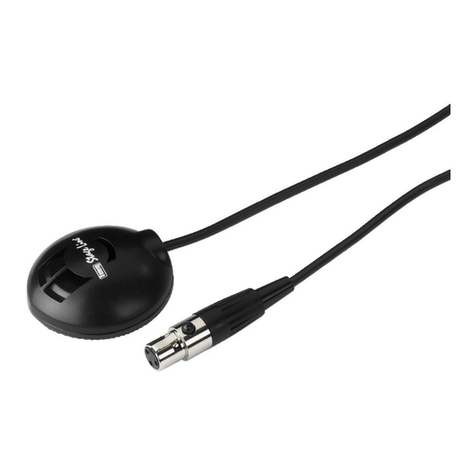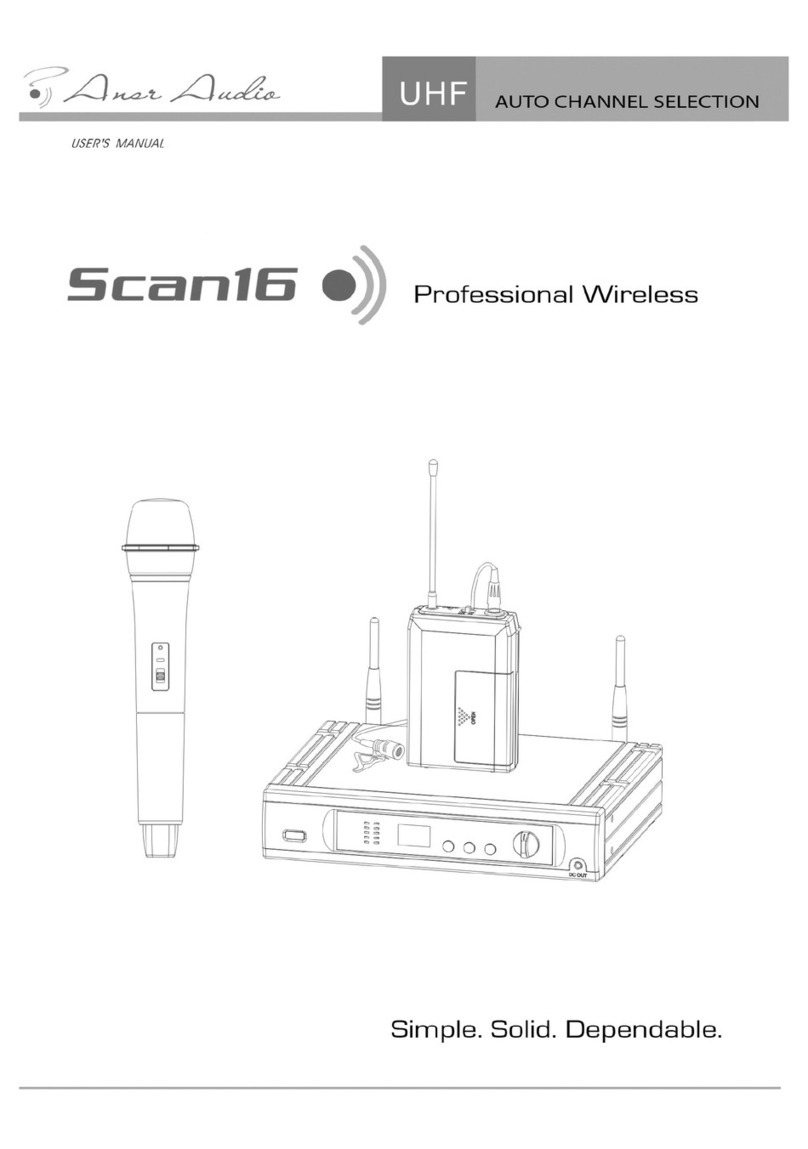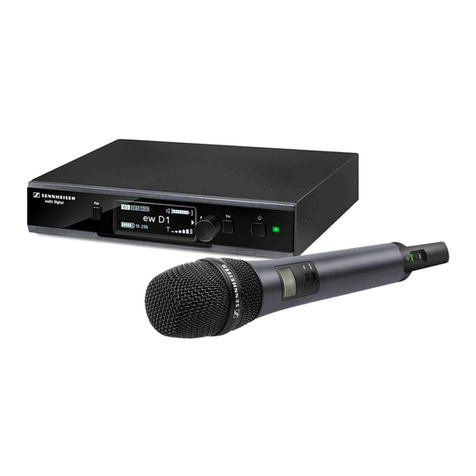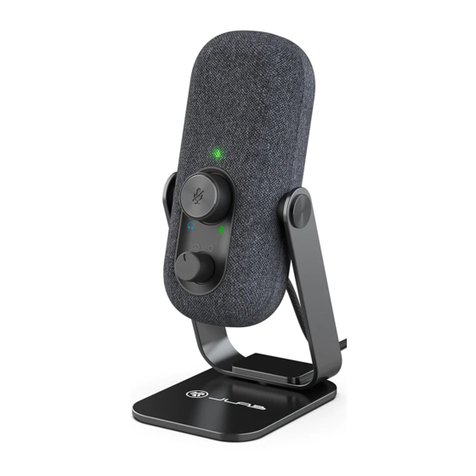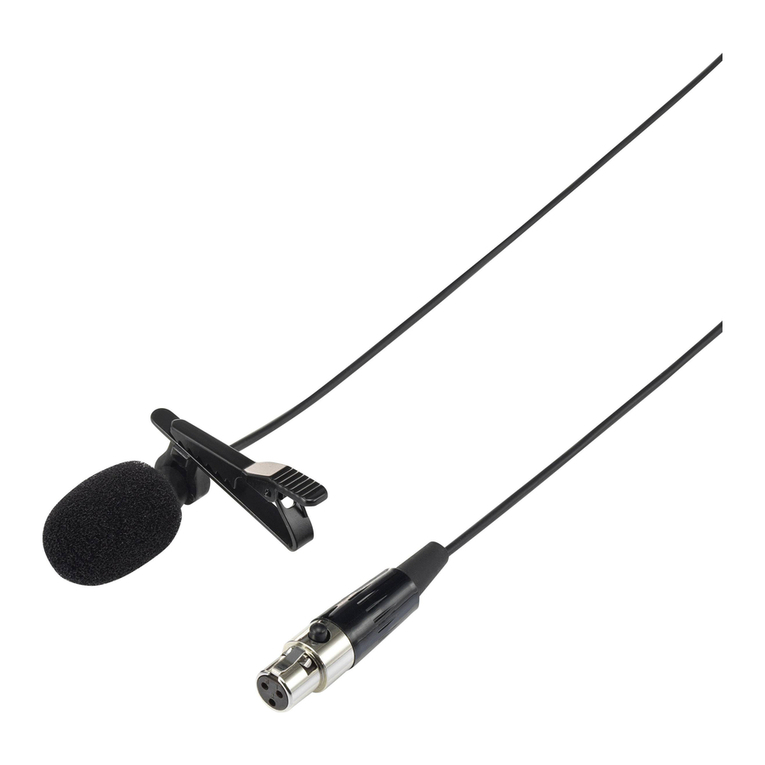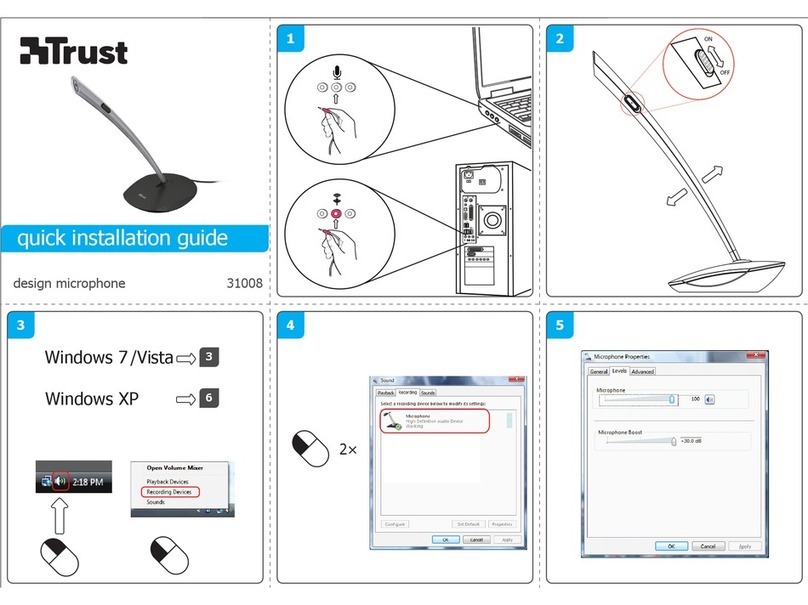
4
12 3
OUTPUT
TO
MIXER
INPUT FROM
MICROPHONE
12
3
IN
914
OR IN 4148
2000
9V
– +
9V
– +
2000
BATTERY POWER SUPPLY
FIGURE 8
can only be used with balanced, floating (ungrounded),
transformer-coupled input mixers such as the Shure M68A.
The
resistors should be 1% tolerance or better to assure
close
matching.
With new batteries, this supply will operate an SM81
for approx-imately 200 hours.
LOW-FREQUENCY
RESPONSE SWITCH
The SM81 has a three-position low-frequency response
switch
located on its handle. The switch
is recessed to avoid ac
-
cidental movement, but may be easily moved with the finger-
tips. The user may select either flat response, low-frequency
rolloff
of 6 dB per octave below 100 Hz,
or low-frequency cutof
f
of 18 dB per octave below 80 Hz (see Figure 1). When close-
miking instruments or vocalists, an increase in low-frequency
response
(proximity ef
fect) takes place. Figure 9 illustrates this
effect with the switch in all three positions. Note that the low
frequency response switch may be used to compensate for
proximity effect by selecting the desired low-frequency re-
sponse.
PROXIMITY EFFECT AND COMPENSATION
FIGURE 9
ATTENUATOR
RING
The
SM81 has a switchable 10 dB capacitive attenuator to
prevent
high sound pressure levels from overloading the micro
-
phone’s internal electronics. The attenuator is engaged by ro-
tating
the actuator ring
directly below the grille assembly
. In the
“10”
position, the output of the microphone is reduced by 10 dB,
increasing
the maximum sound pressure level at clipping by 10
dB. The
attenuator ring may be locked in either the “Q” or “10”
position
as
follows. Unscrew the grille and cartridge assembly
by
unscrewing counter-clockwise from the top. T
urn the
actua
-
tor
ring to the “0” or “10” position as desired. Insert the actuator
ring
lock (small clear piece of plastic) in the area
behind the ac
-
tuator
ring between the pin and the edge of the slot, thereby
pre
-
venting
the ring from
turning. Replace the grill and cartridge as
-
sembly.
The amount of attenuation can be increased by changing
the
value of the capacitor in the 10 dB attenuator switch assem
-
bly.
Note that this change must be done carefully and with sub
-
sequent cleaning to avoid possible signal-to-noise degrada-
tion. Unscrew the grille and cartridge assembly
(counterclockwise
from top). Lift
the 10 dB attenuator actuator
ring
up and over the
screw threads. Grasp the center contact of
the
10 dB attenuator
switch assembly and lift upward to remove
it. Obtain a 5% NPO monolithic ceramic capacitor (Centralab
MONO-KAP
CN series or equivalent) of the required value for
the desired attenuation
Attenuation Capacitance
–15 dB 270 pF
– 20 dB 560 pF
– 25 dB 1000 pF
– 30 dB 1800 pF
Using
long-nose pliers and a low-wattage, pencil-type sol
-
dering
iron, carefully remove the capacitor from the switch as
-
sembly
and replace it with the new value. T
ake care not to touch
the
switch assembly with the soldering iron. T
o remove possible
contamination,
after soldering wash the entire switch assembly
in
a mild detergent solution, rinse it in distilled water
, soak it in
alcohol
to remove the water
, and allow it to air dry
. Reassemble
the
SM81. Note the new attenuation value on the SM81 attenu
-
ator ring with a small label.
MIXER
OVERLOAD
The
SM81 output is about 15 dB higher than most dynamic
microphones, in order to provide optimum signal-to-noise ratio.
When used at moderate to high SPLs, this additional output
may
overload the mixer input. A resistive attenuator
can be in
-
serted in the microphone line ahead of the mixer to minimize
this. The Shure Model A15AS Attenuator (15, 20, or 25 dB
switch-selectable)
is specially designed for use with condenser
microphones.
A convenient 15 dB attenuator design is shown in
Figure 10. The resistors shown are 1
12-watt, 1%
tolerance,
and
the circuit may be packaged in a Switchcraft S3FM adapter
housing.
The 15 dB attenuator can be used between the SM81
and the PS1A (or other power supply), or between the PS1A
and
the mixer
. T
wo of these attenuators may be used in series
to provide 30 dB of attenuation. Note that commercially avail-
able
150
Ω
attenuators (such as the Shure
Model A15AS) are
not recommended, due to loading.
12
3
OUTPUT
TO
MIXER
INPUT FROM
MICROPHONE
1
23
412
412
215
15 DB ATTENUATOR CIRCUIT
FIGURE 10
WIND
NOISE
The excellent frequency response of professional con-
denser
microphones such as the SM81 makes them quite sen
-
sitive to wind, breath, and air currents from ventilation equip-
ment. The resulting low-frequency microphone output may
cause
mixer overload or other problems. The Model A81G Pop
Filter
Grille attenuates breath popping sounds when the micro
-
phone is close-talked, and permits its use outdoors with mini-
mal pickup of rushing and rumbling sounds.
Slip the A81G over the SM81 until the inside of the A81G
touches
the top of the microphone. T
ighten the A81G by rotat
-
ing
the knurled collar clockwise from the bottom. When remov
-
ing the A81G, loosen the knurled collar first (otherwise the car
-
tridge will unscrew with the A81G).
For outdoor use under very windy conditions, the Model
A81WS Heavy-Duty Windscreen is recommended.
